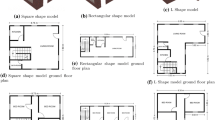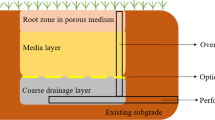Abstract
The behavior of a rainwater harvesting system depends on some variables that cannot be controlled, such as rainfall, building roof size and water consumption. The selection regarding rainwater tank-size will affect the performance of the system and the cost–benefit ratio. The criterion employed for this selection is based on the need for volume-storage and typically, yield large-sized rainwater tanks, especially when the amount of rainwater is higher during rainy seasons. This article presents a methodology for modelling rainwater harvesting, storage, and water consumption, for different configurations of a set of buildings, called clusters, where all buildings collect, store and consume water. This methodology allows for analyzing with different indicators, what is the best recommended configuration and tank-sizing, based on configuration and storage ratio exhibited, thus avoiding the situation of being underutilized. The proposed methodology is applied to a case of study at a university, in Mexico City. In this study case, the dynamics per day is modeled over a year, considering monthly rainfall averages, over 2 groups made up out of 4 buildings with different collecting capabilities and consumption each, allowing for the analysis of 9 cluster configurations and 4 rainwater tank-sizing dimensions. The results are analyzed by means of annual indicators such as: the decrease in the volume used from the public water network, the days of autonomy of the system, and a coefficient \(R\) (which relates the volume spilled to the empty volume). This coefficient is then used selection regarding rainwater tank-sizing and the most recommended cluster configuration.








Similar content being viewed by others
References
Amos CC, Ahmed A, Rahman A (2020) Sustainability in water provision in rural communities: the feasibility of a village scale rainwater harvesting scheme. Water Resour Manage 34:4633–4647. https://doi.org/10.1007/s11269-020-02679-1
Breña PAF, Breña NJA, Francisca NM (2009) Costo de energía eléctrica del m3 de agua abastecida por los sistemas de bombeo en la zona metropolitana del Valle de México. IX Seminario Iberoamericano sobre Planificación, Proyecto y Operación de Sistemas de Abastecimiento de Agua. Valencia, España
CICESE (2020) CLICOM. http://clicom-mex.cicese.mx/mapa.html. Accessed 26 Apr 2021
Concha LP, Campos GJP, Lall U, Ennenbach M (2020) A city wide assessment of the financial benefits of rainwater harvesting in Mexico City. J Am Water Resour Assoc 56(2):247–269. https://doi.org/10.1111/1752-1688.12823
Cook S, Sharma A, Chong M (2013) Performance analysis of a communal residential rainwater system for potable supply: a case study in Brisbane, Australia. Water Resour Manage 27:4865–4876. https://doi.org/10.1007/s11269-013-0443-8
Hanson LS, Vogel RM (2014) Generalized storage-reliability-yield relationships for rainwater harvesting systems. Environ Res Lett 9(75007). https://doi.org/10.1088/1748-9326/9/7/075007
Lawrence D, Lopes VL (2016) Reliability analysis of urban rainwater harvesting for three texas cities. J Urban Environ Eng 10(1):124–134. https://doi.org/10.4090/juee.2016.v10n1.124134
Matos C, Santos C, Pereira S, Bentes I, Imteaz MA (2014) Rainwater storage tank sizing: case study of a commercial building. Int J Sustain Built Environ 2:109–118. https://doi.org/10.1016/j.ijsbe.2014.04.004
Monzur AI, Sameer S (2022) Superiority of water balance modelling for rainwater harvesting analysis and its application in deriving generalized equation for optimum tank size. J Clean Prod 342(130991). https://doi.org/10.1016/j.jclepro.2022.130991
OHIIUNAM (2020) https://www.oh-iiunam.mx/index.html. Accessed 12 Feb 2021
Santos C, Taveira PF (2013) Analysis of different criteria to size rainwater storage tanks using detailed methods. Resour Conserv Recycl 71:1–6. https://doi.org/10.1016/j.resconrec.2012.11.004
Shadeed S, Alawna S (2021) Optimal sizing of rooftop rainwater harvesting tanks for sustainable domestic water use in the West Bank, Palestine. Water 13:573. https://doi.org/10.3390/w13040573
Solorzano VJO, Gomez NJ, Caudex VPO (2019) Methodology to estimate the relationship of water consumption and rainwater harvesting system in a building located at the Universidad Autónoma Metropolitana, Azcapotzalco, Mexico. Tecnología y Ciencias del Agua 10(6):178–196. https://doi.org/10.24850/j-tyca-2019-06-07
Singh PK, Yaduvanshi BK, Patel S, Ray S (2013) SCS-CN based quantification of potential of rooftop catchments and computation of ASRC for rainwater harvesting. Water Resour Manage 27:2001–2012. https://doi.org/10.1007/s11269-013-0267-6
Sultana R (2022) Optimum tank size for large rainwater harvesting system. AWWA Wat Sci e1277. https://doi.org/10.1002/aws2.1277
Ward S, Memon FA, Butler D (2010) Rainwater harvesting: model-based design evaluation. Water Sci Techno 61(1):85–96. https://doi.org/10.2166/wst.2010.783
Zavala MAL, Cruz PMJ, Rojas RCA (2018) Rainwater harvesting as an alternative for water supply in regions with high water stress. Water Supply 18(6):1946–1955. https://doi.org/10.2166/ws.2018.018
Funding
The authors declare that no funds, grants, or other support were received during the preparation of this manuscript.
Author information
Authors and Affiliations
Contributions
GNJ and MGM proposed and coordinated the general methodology of the article, as well as collected the field data regarding the water consumption censuses. MR oversaw calculating the Rainwater Capture Potential. GBBA programmed the calculation algorithms that allowed to determine the Optimal rainwater tank sizing of the different cluster configurations. BQID developed the methodology to conduct water consumption censuses. All authors read and approved the final manuscript.
Corresponding author
Ethics declarations
Competing Interests
The authors have no relevant financial or non-financial interests to disclose.
Additional information
Publisher's Note
Springer Nature remains neutral with regard to jurisdictional claims in published maps and institutional affiliations.
Highlights
• A new definition: cluster rainwater harvesting system.
• A new method to determine the optimum tank size.
• Different parameters to measure the performance of different cluster configurations and different tank sizes.
• Algorithm to model the performance of different cluster configurations and different tank sizes.
Appendix
Appendix
Rights and permissions
Springer Nature or its licensor holds exclusive rights to this article under a publishing agreement with the author(s) or other rightsholder(s); author self-archiving of the accepted manuscript version of this article is solely governed by the terms of such publishing agreement and applicable law.
About this article
Cite this article
Gómez Núñez, J., García Martínez, M., Mompremier, R. et al. Methodology to Optimize Rainwater Tank-sizing and Cluster Configuration for a Group of Buildings. Water Resour Manage 36, 5191–5205 (2022). https://doi.org/10.1007/s11269-022-03299-7
Received:
Accepted:
Published:
Issue Date:
DOI: https://doi.org/10.1007/s11269-022-03299-7




